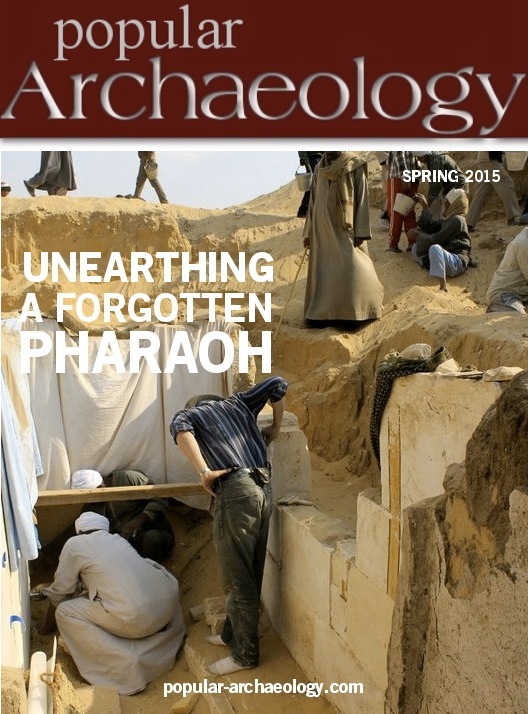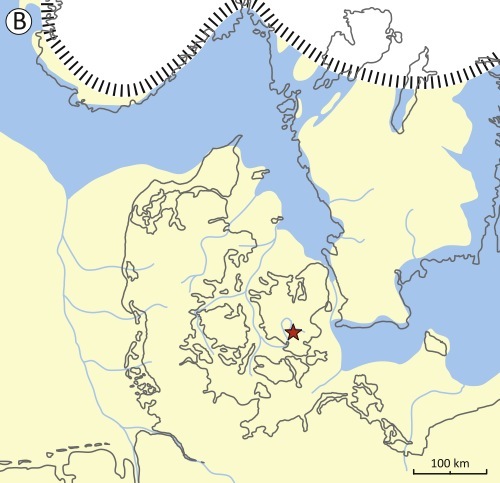
You will not find the archaeological site of Trollesgave on the World Heritage Site list. In its own small way, however, its significance to understanding prehistoric life more than 12,000 years ago in what is today Denmark belies its outward appearance. Scientists who recently examined the site’s artifacts can tell you why.
Located on a sandy plateau near a lake in Denmark, Trollesgave represents evidence of human occupation identified with the Bromme Culture, a Late Paleolithic hunter-gatherer culture that extended across present-day Denmark, southern Sweden, northern Germany, possibly parts of England and Poland, and likely in once-dry areas now covered by the Baltic and North Seas. The Bromme’s typical stone tool markers consist of flint flakes, blades, burins and scrapers that were used for cutting meat, working bones, and working hides, among other uses. They hunted reindeer, moose, wolverine and beaver.
And they lived as families.
That is what Randolph Donahue of the University of Bradford and Anders Fischer of the Danish Agency of Culture have reaffirmed through a re-examination of lithic artifacts previously recovered from Trollesgave in past excavations. They began with what they already knew about the site:
“Its inhabitants would have had easy access to fishing, hunting and provision of large flint nodules of good knapping quality,” state Donahue and Fischer in their report. “Through pollen analysis and radiocarbon dates a lake deposit with dump material from the activity area can be dated to a late part of the climatically mild Allerød biozone, c. 12,700 cal BP. As such, Trollesgave is the only well-dated site from the Bromme Culture—which is the northernmost extension of Late Glacial human habitation currently known in NW Europe. As a result of its preservation and the meticulous excavation, Trollesgave is one of the most informative sites of the Bromme Culture.”*
__________________________________
From the study paper: The location of the Trollesgave site, relative to present-day geography and the extent of land, sea and ice cap during Middle to Late Allerød times. Drawn partly on the basis of the work of Houmark-Nielsen 2012. From R.E. Donahue, A. Fischer, A Late Glacial family at Trollesgave, Denmark, Journal of Archaeological Science (2015), 313 – 324.
_______________________________
Excavations revealed a single hearth, a possible dwelling, and several flint workshops at the site, all dated to the Late Paleolithic. But most recently Donahue and Fischer were able to tease some additional new information based on a combined analytical approach using updated methodologies and tools applied to microwear analysis, flint knapping and artifact spatial distribution. They microscopically examined a total of 307 stone tool artifacts, including end scrapers used for processing hides, burins used for working bone and antler, and tanged points, usually used as projectile points for hunting. From this, along with information previously accumulated about the site, they were able to clarify the functions performed at the site, and thus the nature of the site itself and the suggested makeup of the group that inhabited the site.
“The predominance of dry hide scraping over fresh hide working indicates that the assemblage was produced by a residential group, and not a task group,” concluded the researchers. Moreover, many of the worked lithics were clearly the product of at least one experienced, skilled knapper, others from that of an individual with intermediate knapping abilities, and yet others from an unskilled knapper. “The results from microwear analysis and from refitting, indicating an inexperienced (young child) knapper on-site, indirectly support that there was at least one woman among the residents.”
“Based on the sum of observations and inferences, we conclude that this typical Bromme Culture settlement is a residential site of a single family hunting unit that engaged in various maintenance activities, hunting, and probably fishing.”*
Their study is published in detail as an open access paper in the Journal of Archaeological Science.
________________________________________________
*R.E. Donahue, A. Fischer, A Late Glacial family at Trollesgave, Denmark, Journal of Archaeological Science (2015), 313 – 324.
________________________________________________
 Did you like this? Read more articles like this with a premium subscription to Popular Archaeology Magazine.
Did you like this? Read more articles like this with a premium subscription to Popular Archaeology Magazine.
In addition, the latest Popular Archaeology ebook is now available.
______________________________________________
Travel and learn with Far Horizons.
____________________________________________
 Popular Archaeology’s annual Discovery Edition eBook is a selection of the best stories published in Popular Archaeology Magazine in past issues, with an emphasis on some of the most significant, groundbreaking, or fascinating discoveries in the fields of archaeology and paleoanthropology and related fields. At least some of the articles have been updated or revised specifically for the Discovery edition. We can confidently say that there is no other single issue of an archaeology-related magazine, paper print or online, that contains as much major feature article content as this one. The latest issue, volume 2, has just been released. Go to the Discovery edition page for more information.
Popular Archaeology’s annual Discovery Edition eBook is a selection of the best stories published in Popular Archaeology Magazine in past issues, with an emphasis on some of the most significant, groundbreaking, or fascinating discoveries in the fields of archaeology and paleoanthropology and related fields. At least some of the articles have been updated or revised specifically for the Discovery edition. We can confidently say that there is no other single issue of an archaeology-related magazine, paper print or online, that contains as much major feature article content as this one. The latest issue, volume 2, has just been released. Go to the Discovery edition page for more information.
____________________________________________







